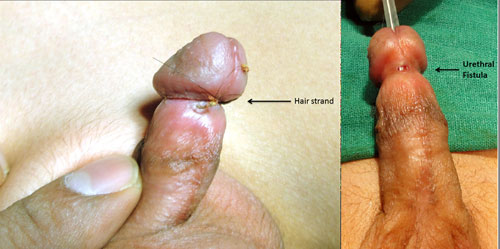|
|
|
Indian Pediatr 2015;52:
538 |
 |
Hair Thread Tourniquet Syndrome of Penis
Causing Urethral Fistula
|
|
*Zarine A Gazali and Arbinder K Singal
Rowhouse D1 Goldmine, Plot no. 138, Sector- 21, Nerul
east, Navi-Mumbai, Maharashtra, India.
Email: [email protected]
|
|
We report a six-year-old boy, who presented to the
Emergency Department with history of poor urine stream and dysuria for
one week. There was no history of fever or urinary retention. General
physical and abdominal examination was normal. Local examination showed
a tight band of hair around the shaft of penis in coronal sulcus causing
a tourniquet-like compression (Fig. 1). The glans was
engorged and the band of hair seemed to be buried into urethra
ventrally.

(a)
(b) |
|
Fig. 1 Tourniquet-like compression of
penis by hair (a); urethral fistula (b). (See color image
at website).
|
The child was taken up for an emergency surgery under
general anesthesia. The band of hair was identified and transected
dorsally. A coronal urethral fistula was seen ventrally where tourniquet
had eroded through (Fig. 2). Edges of the urethra were
mobilised and closed in transverse fashion. Since the area at coronal
sulcus was narrow, a soft tissue and penile skin advancement flap was
fashioned from the lateral penile skin and advanced medially. A two
layer suturing of the flap was done to cover the area of urethral repair
and coronal sulcus to prevent the recurrence of fistula. An indwelling
8fr urethral catheter was left that was removed post-operatively after 7
days. At one year follow-up, the child was passing urine well without
any complaints. No explanation could be offered by parents as to how the
child developed hair thread tourniquet syndrome (HTTS). HTTS, described
first in 1832, is a very rare entity [1,2].
Human hair is thin and supple and stretch in a wet
state, but on drying up becomes tight and can lead to a constriction
band. This constriction band causes ischemia in parts distal to the
tourniquet thus formed [3]. HTTS may involve external appendages or
external genital organs. Digital involvement is seen more frequently in
infants [4] while genitalia are often involved in age group of 4-11
years. When HTTS involves the genitalia, the associated embarrassment
may delay the clinic visit and may lead to complications such as
urethral fistula, urethral transection, and penile gangrene or
amputation [5]. . HTTS in
penis is more commonly seen in circumcised boys [6], and they should be
evaluated for HTTS if they present with penile or glanular swelling,
gangrenous glans, or discharge from coronal sulcus. Removing the
tourniquet with scissors or forceps under magnification or soaking body
part in depilatory cream to weaken the fiber may release the tourniquet
effect. Emergency surgery is needed in those with complications or
failure or conservative treatment.
References
1. Abel MF, McFarland R. Hair and thread constriction
of the digits in infants: A case report. J Bone Joint Surg.1993;
75:915-6.
2. Claudet I, Pasian N, Debuisson C, Salanne S,
Rekhroukh H. Tourniquet syndrome: Interest of a systematic analysis of
familiesí social conditions to detect neglect situations. Child Abuse
Neglect. 2009;33:569-72.
3. Bangroo AK, Smita C. Hair tourniquet syndrome. J
Indian Assoc Pediatr Surg. 2005;10:55-6.
4. Golshevsky J, Chuen J, Tung PH. Hair-thread
tourniquet syndrome. J Pediatr Child Health. 2005;41:154-5.
5. Badawy H, Soliman A, Ouf A, Hammad A, Orabi S,
Hanno A. Progressive hair coil penile tourniquet syndrome: multicenter
experience with 25 cases. J Pediatr Surg. 2010;45:1514-8.
6. Kirtane JM, Samuel KV. Hair coil strangulation of
the penis. J Pediatr Surg. 1994;29:1317-8.
|
|
|
 |
|

